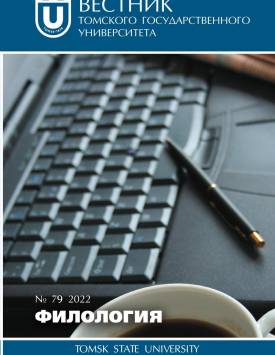The poetic persona of the “knight behind the visor” in the works of Nikolay Gumilyov and Maria Levberg, and the literary tradition
The article examines the poetic persona of the “knight behind the visor” in Nikolay Gumilyov’s and Maria Levberg’s lyric works in comparison with the poetry of the Silver Age. In one of his “Letters on Russian Poetry”, Gumilyov criticized the use of this poetic persona in the debut book of poems by Maria Levberg, although the image of a knight is also essential for his own lyrics. The article sets several objectives: (1) to determine how much of a “cliche” the poetic persona of the “knight behind the visor” was in Russian poetry before 1915; (2) to show the evolution of this poetic persona in Gumilyov’s works and try to explain his criticality in relation to it; (3) to identify the features of this role in Levberg’s poetry. The first part of the article shows what essential motifs are associated with the poetic persona of the “knight behind the visor” in the poetry of the Silver Age. It is fundamentally important in the works of Aleksandr Blok, Andrey Bely, Ellis, appears in works by Valery Bryusov, Sergey Solovyov, Yury Verkhovsky, Ilya Ehrenburg, as well as by female poets Elizaveta Dmitrieva (Cherubina de Gabriak) and Elizaveta Kuzmina-Karavaeva. The image of the knight was associated with the theme of service, first of all, to Christ and the Virgin Mary and, in the earthly projection, to the lady, the motif of sublime and/or hopeless love; church theme, Catholic asceticism and mysticism; the theme of pilgrimage, exotic travels to a lofty goal; motifs of battle, duel, death, and wound, as well as the image of the enemy, which often takes the forms of a demon (or Devil himself) and a dark wizard; literary and cultural associations (Knights of the Round Table, Knights of the Grail, Lohengrin, Tannhauser, Parsifal, Don Quixote, Roland, etc.). The figure of the dark double is also associated with the motif of the enemy. In connection with the understanding of chivalry as service, it is identified with a poetic vocation. The second part of the article aims to demonstrate the evolution of this poetic persona in Gumilyov’s poetry. Along with the reproduction of the tradition and its topoi in some of his poems, Gumilyov also carried out a “recoding” of the image, using its associations with pilgrimage to distant countries, exotic travels, the motif of conquest and connecting it with the images of a sailor, a conquistador, a warrior in general. From the middle of 1910 to the spring of 1913, the image of a knight almost disappears from Gumilyov’s lyrics and is interpreted as deeply non-modern, as an elegiac memory, but at the same time the most important self-characterization as “warrior and poet” emerges. In later lyrics, the knight is polemically - in the Acmeist spirit - called the “Knight of Happiness” who defends the beauty of earthly life. The third part of the article describes the peculiarity of the knightly poetic persona in the poetry of Maria Levberg. The peculiarity is connected with the fact that this woman author encroaches on the specifically masculine role. This image turns out to be as important and frequent in Levberg’s poetry as in no other by female poets of the Silver Age. Levberg creates a very unique image of the knight - graceful, sly and melancholic, full of doubts, but longing for a miracle. The motif of wandering is fundamental for her, linking the knightly mask with other poetic personas of her book A Sly Wanderer. This is a wandering in an attempt to find a “miracle”, i.e., to get rid of longing and melancholy, to find some high purpose and peace of mind. The author declares no conflicts of interests.
Keywords
Nikolay Gumilyov, Maria Levberg, poetic persona, knight, Silver Age, literary traditionAuthors
| Name | Organization | |
| Zuseva-Ozkan Veronika B. | Gorky Institute of World Literature of the Russian Academy of Sciences | v.zuseva.ozkan@gmail.com |
References

The poetic persona of the “knight behind the visor” in the works of Nikolay Gumilyov and Maria Levberg, and the literary tradition | Vestnik Tomskogo gosudarstvennogo universiteta. Filologiya – Tomsk State University Journal of Philology. 2022. № 79. DOI: 10.17223/19986645/79/11
